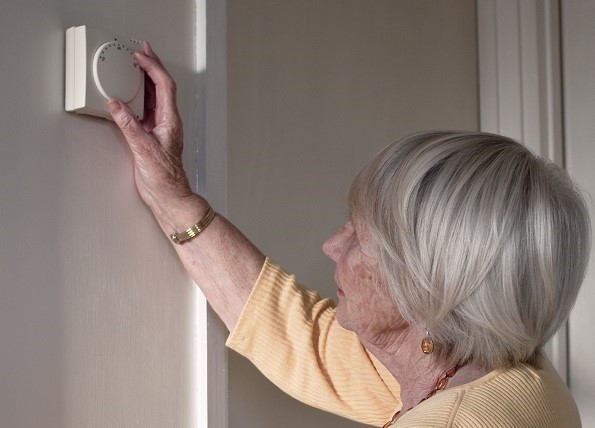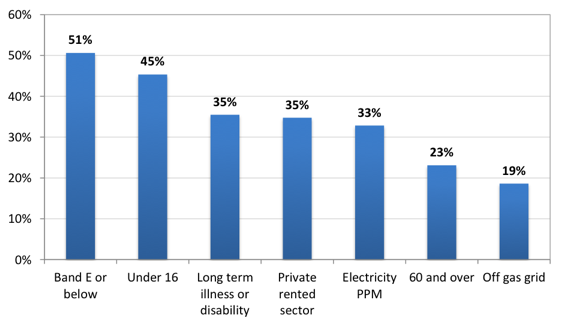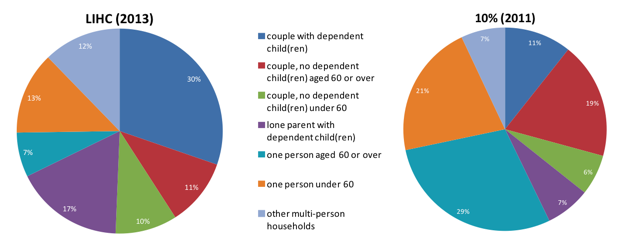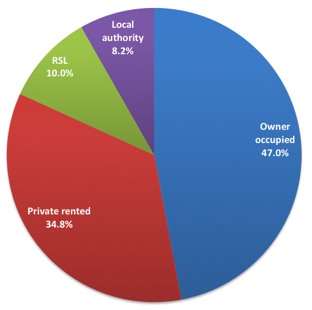Who is affected by fuel poverty?

Credit: ©iStock/tbradford
On this page:
Approximately 2.35 million English households are estimated to be in fuel poverty in 2015 according to the new government definition1 in the Warm Homes and Energy Conservation Act: ‘A person is to be regarded as living “in fuel poverty” if he is a member of a household living on a lower income in a home which cannot be kept warm at reasonable cost’2. Fuel poverty is caused by three main issues: low incomes, energy inefficient homes and energy prices.3
The UK government has recently changed the definition of fuel poverty used in England. Previously a household which needed to spend 10% or more of its total income to heat the home to an ‘adequate level of warmth’ was considered to be in fuel poverty, while anyone required to spend more than 20% was considered to be in severe fuel poverty. The devolved governments in other parts of the UK are still currently using this definition.
In 2012, an in-depth review of fuel poverty statistics4 established the ‘low income, high cost’ (LIHC) indicator of fuel poverty as the new official definition for England (see Box 1 below). Essentially, under this definition, a household is in fuel poverty if its required total fuel costs are higher than the national average (median) fuel cost, and, were it to spend that amount, the household's remaining income would be below the standard government definition for poverty. This is illustrated in Figure 1.1 below. Households falling into the shaded area are fuel poor. Households must both be below the income threshold and have expected fuel costs above the average (median) fuel cost. Note that the household’s expected fuel cost is not its actual expenditure on fuel, but the amount that it would have to spend to heat the home to an ‘adequate level of warmth’, being defined as 21°C in the living room and 18°C in the rest of the home. In reality it is more likely that fuel poor households under-heat their homes to reduce their bills.
|
Box 1: The Low Income High Costs Definition of Fuel Poverty
According to the Government’s standard definition of poverty, a household is defined as being in relative poverty if it has an income lower than 60% of England’s median income.
The new low income high costs (LIHC) definition of fuel poverty identifies fuel poor households as those that are pushed into poverty as a result of high fuel costs and low incomes.
Households are defined as being low income (LI) if their remaining income after expenditure on fuel costs is then less than 60% of the median income after housing costs (AHC). Subtracting rent and mortgage costs from a household’s net income allows for the considerable regional variation in housing costs that occurs across England, most notably between London and the North of England.
One way of visualising the thresholds is to plot AHC income plus required fuel costs against fuel costs. As a result the income threshold slopes to the left because of the effect of adding on fuel costs to the income: higher fuel costs pull it more to the right. This is the representation used in the official fuel poverty publications and splits the population into four quadrants (Figure 1.1)
-
Low income, high costs (these are the fuel poor, in the bottom left quadrant)
-
Low income, low costs (top left)
-
High income, high costs (bottom right)
-
High income, low costs (top right).
It is important to note that in this calculation both incomes and fuel costs are ‘equivalised’; this is a statistical process that levels incomes and fuel costs to account for different compositions and numbers of people in households across the country. For incomes, the main purpose of this is to account for larger households requiring higher overall incomes to maintain the same standard of living as smaller households.
Fuel costs are equivalised using a specific set of factors determined for the purposes of the LIHC definition using total household size (total number of people). These are different from the factors used for income. Analysis of available survey data[1] suggests that the size of a household has the most significant impact on fuel bills. Calculated ‘required’ fuel costs are divided by the equivalisation factors shown in the table, in order to produce equivalised fuel costs.
|
Number of people in household
|
Fuel cost equivalisation factors for LIHC definition
|
|
1
|
0.82
|
|
2
|
1
|
|
3
|
1.07
|
|
4
|
1.21
|
|
5 or more
|
1.33
|
|

Figure 1.1: Representation of low income, high cost (LIHC) indicator5
The LIHC indicator measures both the number of households experiencing fuel poverty and also the 'depth' of fuel poverty or ‘fuel poverty gap.’ This is the gap between how much a household needs to spend to maintain a warm home (taking account of household size) and the average cost of heating a home, taking into account their income, if appropriate. This can be thought of as the amount by which bills would have to decrease to take the household out of fuel poverty. In Figure 1.1, it is the distance that they would have to move upwards to leave the shaded area. The total and average fuel poverty gap is usually reported alongside the headline total number of fuel poor. For both definitions, fuel poverty statistics are modelled, based on the English Housing Survey. DECC publishes a description of the modelling methodology6.
Under the new indicator, fewer households are classified as fuel poor in comparison with the previous definition. The new indicator puts the number of households in fuel poverty in England at 2.35 million (2013), compared to 3.2 million under the previous definition (2011). This is a change from 14.6% of households to 10.4% of all households classified as being in fuel poverty. Furthermore, the number of fuel poor households considered to be vulnerable (that is, containing ‘the elderly, children or someone who is disabled or has a long term illness’) fell from 2.5 million to 1.8 million7 (Table 1.1). Both definitions are used here, (depending on the data provided by the source documents), indicating which definition is used each time. Where possible, the LIHC indicator, as the most up to date one for England, is used.
|
|
Old 10% Definition (2011 data)
|
New LIHC Definition (2013 data)
|
|
All fuel poor households
|
3,202,000
|
2,347,000
|
|
Of these, households which are vulnerable (i.e. containing the elderly, children, or someone who is disabled or has a long term illness)
|
2,498,000
|
1,821,000
|
Table 1.1: Households in fuel poverty according to 10% definition (2011) and LIHC definition (2013)8
While it is generally accepted that three key factors create fuel poverty: energy inefficient properties, high energy bills and low incomes, some groups are more likely to experience fuel poverty. All figures given below are according to the LIHC definition9:
-
People in inefficient homes: 51% of all fuel poor households have an Energy Performance Certificate (EPC) rating of E or below.
-
Young people: 45% of all households experiencing fuel poverty include at least one person under the age of 16.
-
People with a disability or long term illness: 35% of all fuel poor households include at least one person with a disability or a long term illness.
-
Tenants in the private rented sector (PRS): 35% of all people experiencing fuel poverty live in privately rented homes. This is double the combined percentage associated with homes which are rented from a local authority (8%) or through a housing association (10%).
-
People using pre-payment meters (PPM): 33% of all fuel poor households use an electricity PPM. This is low compared to other groups due to the relatively small proportion of people using this form of payment compared to others such as direct debit.
-
Older people: just over 23% of all fuel poor households include at least one person over the age of 60.
-
Households not connected to mains gas (known as off gas12) households are usually found in rural areas and rely on more expensive heating options, such as electricity, oil and solid fuel. Due to the fact that the majority of households in England are connected to the gas network, only 19% of all households experiencing fuel poverty fall into the off gas13 category. However, the depth of fuel poverty for these households can be severe, with the average fuel poverty gap14 for households in non-cavity walled properties off the gas grid being £789, compared to £412 for the same types of properties located on the gas grid.
-
Figure 1.2 illustrates the figures, highlighting what proportion of all fuel poor households in England have each characteristic described above. For example, 35% of all households experiencing fuel poverty in England live in private rented accommodation. Note that the characteristics are not mutually exclusive; for example a private sector tenant may also have a long term illness or a person over 60 may also live in a property with a low EPC rating.

Figure 1.2: At-risk characteristics for fuel poverty, showing the percentage of all fuel poor households found in each group (LIHC indicator)10
A large proportion of households with under 16s are fuel poor, which reflects the fact that larger households have higher living costs and therefore their incomes (adjusted for living costs) is lower, which pushes them into fuel poverty. One of the reasons for defining a new fuel poverty indicator was that the 10% indicator did not account for the number of people in the household, leading to too many small households (i.e. single people and couples) being counted as fuel poor, and not enough large ones (i.e. families). Accounting for the size of the household in the LIHC has changed this balance, and as a result more households with children are identified as fuel poor.
Disabled people are twice as likely to live in poverty as non-disabled people, making them more likely to experience fuel poverty.11 Disabled people are far less likely to be in employment than non-disabled people, and when in work they earn less on average. They are also less likely to have savings. Given that low income is one of the strongest indicators of fuel poverty, the increased likelihood of disabled people living on a low income almost certainly means a greater likelihood of experiencing fuel poverty.12
Under the LIHC measure of fuel poverty, in 2013, 12% of households containing someone with a long term illness or disability were fuel poor.13 Under the 10% measure, this figure was 17.4% in 2011.14 According to the English Housing Survey 2010-11,15 20% of households containing at least one member with a mental health problem experience fuel poverty. Cutting back on fuel costs is common among those people living with a disability who have low income and debts to pay off.16
Almost a quarter of households (23%) experiencing fuel poverty in 2013 included at least one person aged over 60 under the LIHC definition, compared to double this figure under the old definition in 2011.17 The large difference is due to many older people on low incomes living alone in properties that are larger than required to meet their needs and which are expensive to heat. Under the 10% definition of fuel poverty, these households are classified as being fuel poor, but under the LIHC indicator, fuel costs are adjusted for household size, therefore reducing the fuel costs used in the calculation for these households.
Figure 1.3 shows the proportion of all fuel poor households in England by household composition in 2013, using the LIHC definition, and comparing that with the 10% definition (using 2011 data, the most recent available). Under the LIHC definition, couples with dependent children form the largest proportion at 30%, followed by lone parents with dependent children at 17% and lone people under 60 at 13%. In contrast, the 10% definition shows one person households aged 60 or over to be the largest group.

Figure 1.3: Proportion of all fuel poor households by household composition, 2013 (LIHC definition) (DECC, 2015)18
Older people living on fixed pensions have little opportunity to increase their income and so have fewer opportunities to combat fuel poverty. While fuel poverty is more prevalent among families than among older households (under the LIHC indicator), families are more likely to move into and out of fuel poverty (for example, becoming fuel poor as the family becomes larger and one adult stops working to take care of children, and moving out of fuel poverty when children are older if both adults are working again). In contrast, older households on fixed pensions have fewer possibilities to move out of fuel poverty.
Fuel poverty among older people can be particularly acute in rural areas. This is because houses in rural areas tend to have lower energy efficiency and may not be connected to the gas grid, meaning that people have to use more expensive heating fuels, such as oil, solid fuel, or electricity for heating their homes.19
In England there were over 1.1 million households with dependent children living in fuel poverty in 2013. Of these, 1,064,000 households had at least one child under the age of 1620 (see Table 1.2).
|
Household Type
|
England
|
|
All fuel poor households
|
2,347,000
|
|
Households with dependent children
|
1,112,000
|
|
Of which households with under-16s
|
1,064,000
|
Table 1.2: Breakdown of English Households for 2013 – LIHC Definition21
A 2012 survey by the national children’s charity Barnardo’s found that the increasing austerity of the last three years has led to 84% of the families they work with cutting back on heating. In addition 74% were cutting back on food; and 60% cutting back on buying clothes.22 Many were in debt to their gas or electricity supplier and were cutting back spending on essentials in order to pay their energy bills.
Living in a cold home has negative impacts on children’s health and wellbeing. For example, there is evidence for both lower weight gains in young children and babies and also increased hospital admission rates for children.23
Children who live in privately rented accommodation are more commonly affected by fuel poverty than children living in other tenures. Under the 10% indicator, nearly 15% of dependent children living in privately rented housing are living in fuel poverty, compared to around 9-10% of children living in all other tenures (see Table 1.3). Equivalent figures are not available for the LIHC indicator, but are likely to be higher given the LIHC indicator's emphasis on household size.
|
|
Number of children in fuel poverty
|
% of children in fuel poverty in each tenure
|
|
Housing associations
|
220,552
|
16.06%
|
|
Owner occupied homes
|
1,038,316
|
16.10%
|
|
Local authority housing
|
152,472
|
15.25%
|
|
Private rented accommodation
|
815,233
|
30.70%
|
Table 1.3: Dependent children in fuel poverty by tenure in England, 2013, using LIHC definition (source: EHS 2013)24
One in five private rented sector households live in fuel poverty according to the LIHC definition, the highest proportion of any tenure type.25 Private rented households make up 35% of all fuel poor households in England, as shown in Figure 1.2 and Figure 1.4. Those who rent generally have lower incomes than owner occupiers.26 Currently, the supply of social housing in the UK does not meet demand, leaving many vulnerable households in the less regulated, more expensive private sector. Rents in this sector are considerably higher, at £176 per week on average, compared with £98 for housing association renters and £89 for local authority renters.27 This leaves a much lower household income to spend on household fuel.

Figure 1.4: Fuel poor households by tenure (DECC, 2015)28
The private rented sector is growing, potentially meaning more households may be at risk of fuel poverty. Between 2001 and 2011, the number of households renting privately in England increased to 3.7 million (an increase from 12% to nearly 17% of households).29
The private rented sector has a greater proportion of energy inefficient homes than other tenures. The private rented sector is twice as likely to be of a non-decent standard compared to social housing (30% compared to 15%) and is also more likely to have a lower EPC rating.30 While the government has provided funding for improvements to social housing through the Decent Homes programme (which has an element covering thermal comfort)31, the private rented sector is not included in the scheme. This is a significant problem as private sector properties are more likely to be older and therefore more expensive to insulate32 and there is little incentive for private landlords to pay for such improvements.
Properties in the private rented sector may have fewer main heating options compared to other tenure types. Many have no gas connection or the gas connection is not used.33 Heating systems in privately rented properties can often be old, inefficient and poorly maintained, which can lead to higher operating costs.34 People living in private rented homes are over four times more likely to be living in a cold home than people living in social housing.35 Over 400,000 privately rented homes are classified as a Category 1 ‘excess cold’ hazard under the Housing, Health and Safety Rating System (HHSRS).36 This is around a tenth of all privately rented homes in England.
|
Tenure
|
Sample size
|
Mean SAP
|
|
Owner occupied
|
4,994
|
58.5
|
|
Privately rented
|
2,590
|
58.4
|
|
Social rented
|
|
|
|
Local authority
|
2,214
|
64.9
|
|
Housing association
|
2,700
|
66.2
|
|
All social rented
|
4,914
|
65.6
|
|
All tenures
|
12,498
|
59.7
|
Table 1.4: Energy efficiency rating for housing in different tenures (EHS, 2013-14)37
Households that use prepayment meters are more likely to experience fuel poverty than those paying by other means. One quarter of all households using prepayment meters are fuel poor, compared to less than one in ten of those paying by direct debit and one in six of those paying by standard credit. Some low income households prefer prepayment meters even when they know these are more expensive because it enables them to more easily manage and keep within their budgets, but as a result, they may be suffering a poverty premium.
Households using prepayment meters are most affected by price rises because these have an immediate effect, compared to households on fixed price credit tariffs or direct debit payments. These other forms of payment allow costs to be spread, so households have more time to adjust to price rises.38
Three quarters of fuel poor households (LIHC definition) live in properties characterised by low energy efficiency, with an E, F or G Energy Performance Certificate (EPC) rating.39 EPC ratings range from band A, with 92-100 SAP points (the most efficient) to band G, with 1-20 SAP points (the least efficient).40
Terraced or semi-detached properties with pre-payment meters, non-cavity walls, built before 1945 and with fixed or portable heating are more likely to have low EPC ratings.41 Solid walled properties make up 45% of all homes occupied by fuel poor households (LIHC indicator) despite only representing around 30% of the total housing stock, while more than two thirds of fuel poor households live in either terraced or semi-detached properties. Houses built before 1945 account for two thirds of the aggregate fuel poverty gap. As such, properties are harder to insulate, due to either being either solid walled or having narrow cavities that are harder to fill. These older properties are also home to over half of all fuel poor households living in fuel poverty, despite accounting for just over a third of properties nationally.
In very hot weather, overheating can be a problem in both poorly insulated properties and some well insulated properties. Under-insulated top floor flats can suffer from overheating in very hot weather.42 Studies have also found that overheating can be a problem in well insulated buildings43, linked to high air tightness and poor ventilation, and so it is important when retrofitting insulation to take account of solar and internal heat gains and to make sure there is adequate ventilation.44 See the section on adapting buildings for more information.
Back to the top



